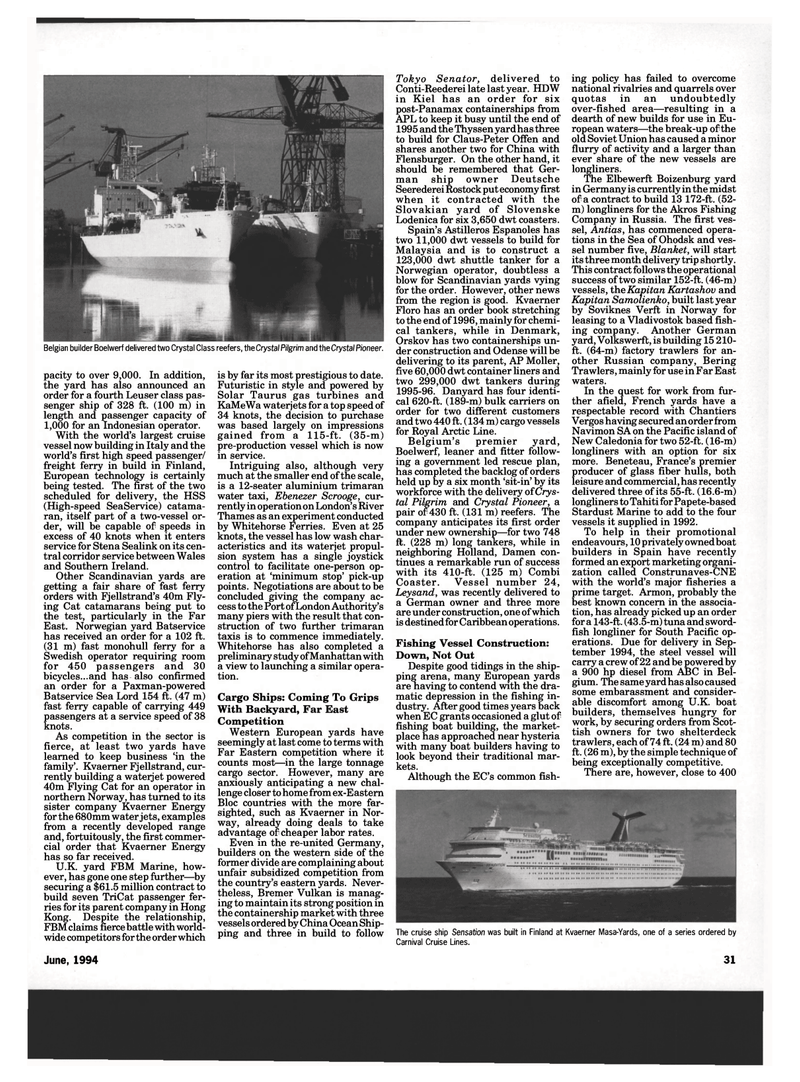
Page 25: of Maritime Reporter Magazine (June 1994)
Read this page in Pdf, Flash or Html5 edition of June 1994 Maritime Reporter Magazine
Belgian builder Boelwerf delivered two Crystal Class reefers, the Crystal Pilgrim and the Crystal Pioneer. pacity to over 9,000. In addition, the yard has also announced an order for a fourth Leuser class pas- senger ship of 328 ft. (100 m) in length and passenger capacity of 1,000 for an Indonesian operator.
With the world's largest cruise vessel now building in Italy and the world's first high speed passenger/ freight ferry in build in Finland,
European technology is certainly being tested. The first of the two scheduled for delivery, the HSS (High-speed SeaService) catama- ran, itself part of a two-vessel or- der, will be capable of speeds in excess of 40 knots when it enters service for Stena Sealink on its cen- tral corridor service between Wales and Southern Ireland.
Other Scandinavian yards are getting a fair share of fast ferry orders with Fjellstrand's 40m Fly- ing Cat catamarans being put to the test, particularly in the Far
East. Norwegian yard Batservice has received an order for a 102 ft. (31 m) fast monohull ferry for a
Swedish operator requiring room for 450 passengers and 30 bicycles...and has also confirmed an order for a Paxman-powered
Batservice Sea Lord 154 ft. (47 m) fast ferry capable of carrying 449 passengers at a service speed of 38 knots.
As competition in the sector is fierce, at least two yards have learned to keep business 'in the family'. Kvaerner Fjellstrand, cur- rently building a waterjet powered 40m Flying Cat for an operator in northern Norway, has turned to its sister company Kvaerner Energy for the 680mm water jets, examples from a recently developed range and, fortuitously, the first commer- cial order that Kvaerner Energy has so far received.
U.K. yard FBM Marine, how- ever, has gone one step further—by securing a $61.5 million contract to build seven TriCat passenger fer- ries for its parent company in Hong
Kong. Despite the relationship,
FBM claims fierce battle with world- wide competitors for the order which is by far its most prestigious to date.
Futuristic in style and powered by
Solar Taurus gas turbines and
KaMeWa waterjets for a top speed of 34 knots, the decision to purchase was based largely on impressions gained from a 115-ft. (35-m) pre-production vessel which is now in service.
Intriguing also, although very much at the smaller end of the scale, is a 12-seater aluminium trimaran water taxi, Ebenezer Scrooge, cur- rently in operation on London's River
Thames as an experiment conducted by Whitehorse Ferries. Even at 25 knots, the vessel has low wash char- acteristics and its waterjet propul- sion system has a single joystick control to facilitate one-person op- eration at 'minimum stop' pick-up points. Negotiations are about to be concluded giving the company ac- cess to the Port of London Authority's many piers with the result that con- struction of two further trimaran taxis is to commence immediately.
Whitehorse has also completed a preliminary study of Manhattan with a view to launching a similar opera- tion.
Cargo Ships: Coming To Grips
With Backyard, Far East
Competition
Western European yards have seemingly at last come to terms with
Far Eastern competition where it counts most—in the large tonnage cargo sector. However, many are anxiously anticipating a new chal- lenge closer to home from ex-Eastern
Bloc countries with the more far- sighted, such as Kvaerner in Nor- way, already doing deals to take advantage of cheaper labor rates.
Even in the re-united Germany, builders on the western side of the former divide are complaining about unfair subsidized competition from the country's eastern yards. Never- theless, Bremer Vulkan is manag- ing to maintain its strong position in the containership market with three vessels ordered by China Ocean Ship- ping and three in build to follow
Tokyo Senator, delivered to
Conti-Reederei late last year. HDW in Kiel has an order for six post-Panamax containerships from
APL to keep it busy until the end of 1995 and the Thyssen yard has three to build for Claus-Peter Offen and shares another two for China with
Flensburger. On the other hand, it should be remembered that Ger- man ship owner Deutsche
Seerederei Rostock put economy first when it contracted with the
Slovakian yard of Slovenske
Lodenica for six 3,650 dwt coasters.
Spain's Astilleros Espanoles has two 11,000 dwt vessels to build for
Malaysia and is to construct a 123,000 dwt shuttle tanker for a
Norwegian operator, doubtless a blow for Scandinavian yards vying for the order. However, other news from the region is good. Kvaerner
Floro has an order book stretching to the end of 1996, mainly for chemi- cal tankers, while in Denmark,
Orskov has two containerships un- der construction and Odense will be delivering to its parent, AP Moller, five 60,000 dwt container liners and two 299,000 dwt tankers during 1995-96. Danyard has four identi- cal 620-ft. (189-m) bulk carriers on order for two different customers and two 440 ft. (134 m) cargo vessels for Royal Arctic Line.
Belgium's premier yard,
Boelwerf, leaner and fitter follow- ing a government led rescue plan, has completed the backlog of orders held up by a six month 'sit-in' by its workforce with the delivery of Crys- tal Pilgrim and Crystal Pioneer, a pair of 430 ft. (131m) reefers. The company anticipates its first order under new ownership—for two 748 ft. (228 m) long tankers, while in neighboring Holland, Damen con- tinues a remarkable run of success with its 410-ft. (125 m) Combi
Coaster. Vessel number 24,
Leysand, was recently delivered to a German owner and three more are under construction, one of which is destined for Caribbean operations.
Fishing Vessel Construction:
Down, Not Out
Despite good tidings in the ship- ping arena, many European yards are having to contend with the dra- matic depression in the fishing in- dustry. After good times years back when EC grants occasioned a glut of fishing boat building, the market- place has approached near hysteria with many boat builders having to look beyond their traditional mar- kets.
Although the EC's common fish- ing policy has failed to overcome national rivalries and quarrels over quotas in an undoubtedly over-fished area—resulting in a dearth of new builds for use in Eu- ropean waters—the break-up of the old Soviet Union has caused a minor flurry of activity and a larger than ever share of the new vessels are longliners.
The Elbewerft Boizenburg yard in Germany is currently in the midst of a contract to build 13 172-ft. (52- m) longliners for the Akros Fishing
Company in Russia. The first ves- sel, Antias, has commenced opera- tions in the Sea of Ohodsk and ves- sel number five, Blanket, will start its three month delivery trip shortly.
This contract follows the operational success of two similar 152-ft. (46-m) vessels, theKapitan Kartashov and
Kapitan Samolienko, built last year by Soviknes Verft in Norway for leasing to a Vladivostok based fish- ing company. Another German yard, Volkswerft, is building 15 210- ft. (64-m) factory trawlers for an- other Russian company, Bering
Trawlers, mainly for use in Far East waters.
In the quest for work from fur- ther afield, French yards have a respectable record with Chantiers
Vergos having secured an order from
Navimon SA on the Pacific island of
New Caledonia for two 52-ft. (16-m) longliners with an option for six more. Beneteau, France's premier producer of glass fiber hulls, both leisure and commercial, has recently delivered three of its 55-ft. (16.6-m) longliners to Tahiti for Papete-based
Stardust Marine to add to the four vessels it supplied in 1992.
To help in their promotional endeavours, 10 privately ownedboat builders in Spain have recently formed an export marketing organi- zation called Construnaves-CNE with the world's major fisheries a prime target. Armon, probably the best known concern in the associa- tion, has already picked up an order for a 143-ft. (43.5-m) tuna and sword- fish longliner for South Pacific op- erations. Due for delivery in Sep- tember 1994, the steel vessel will carry a crew of 22 and be powered by a 900 hp diesel from ABC in Bel- gium. The same yard has also caused some embarassment and consider- able discomfort among U.K. boat builders, themselves hungry for work, by securing orders from Scot- tish owners for two shelterdeck trawlers, each of 74 ft. (24 m) and 80 ft. (26 m), by the simple technique of being exceptionally competitive.
There are, however, close to 400
The cruise ship Sensation was built in Finland at Kvaerner Masa-Yards, one of a series ordered by
Carnival Cruise Lines.
June, 1994 31

 24
24

 26
26
